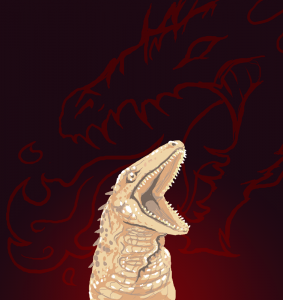An essay by Edmund Teile, as prepared by his great-grandson, Isaac Teile
Art by Leigh Legler
Abstract: This paper asserts that pinwyrm lizards are closely related to western red and northeastern black dragons despite their contemporary classification as monitors. First, I provide an analysis of comparative behavioral habits between venomous pinwyrms and black dragons (which leads me to discuss how I lost my arm). Second, I provide an analysis of existing literature (which leads me to discuss how I lost my eye). Together, the evidence suggests pinwyrms should be reclassified; in fact, traits of pinwyrms and dragons are similar enough to study the evolution of one through the evolution of the other.
Argument: The venomous pinwyrm of northern Y’reth-al-Nir, Pinwyrmes niri, is the northernmost lizard yet discovered (Memnar the Terrible, 491). Four interns and I received a grant from the High Academy of Wizardry and Liberal Arts to spend six months with northern pinwyrms and six months with a northeastern black dragon colony at the ruins of the Vale. Unfortunately, the interns are dead now, but their research lives on.
Most niri are no more than ten inches long with pale skin that helps them to disappear among the snow drifts. Despite the name, the venomous pinwyrm is actually the least poisonous pinwyrm. It has a genetic abnormality that provides thick skin to protect it from the cold (and its own mucus). However, this skin cannot produce the psychedelic venomous coating of its southern cousins. Rather, the name refers to the hot, acidic mucus that it spits to denature its meals. Memnar the Terrible hypothesized the mucus was acetic acid and quite flammable (491). Field tests confirmed this. The exact quote I recorded was, “It burns worse than I’ve ever been burned.”
Perhaps most interesting is that some niri in northernmost Y’reth-al-Nir, beyond the City of the Fallen Spires, beyond the Titan’s statue, beyond even the Great Howling Chasm, actually spit on each other to stay warm. Here, it is to the pinwyrm’s advantage to produce the warmest saliva it can. Some are radically successful; the only animals past the Great Howling Chasm are pinwyrms. Even we could not fend off the frostbite with traditional spells, and I lost two fingers on my left hand. No matter; the whole arm was devoured by a dragon.

Here, it is to the pinwyrm’s advantage to produce the warmest saliva it can. Some are radically successful; the only animals past the Great Howling Chasm are pinwyrms.
To read the rest of this story, check out the Mad Scientist Journal: Summer 2017 collection.
Today, my great-grandfather is remembered for terrifying pop quizzes or the era when his ghost haunted the west residence hall. But he was a brilliant scholar; in an effort to restore his memory, I am presenting his best articles from his years as a preeminent researcher in the field of natural and supernatural evolution.
Isaac Teile wrote Resting in Peace: How the Restless Dead of Tira-no-gortha Finally Learned to Cope with Their Curse and edited A Man of Stature: Edmund Teile’s collected essays. He lives near the Blackened Sea and feeds a lot of stray cats. Follow him on Facebook.
Leigh’s professional title is “illustrator,” but that’s just a nice word for “monster-maker,” in this case. More information about them can be found at http://leighlegler.carbonmade.com/.
“From Matchsticks to Flamethrowers: On the Evolution of Dragons” is © 2017 Isaac Teile
Art accompanying story is © 2017 Leigh Legler
